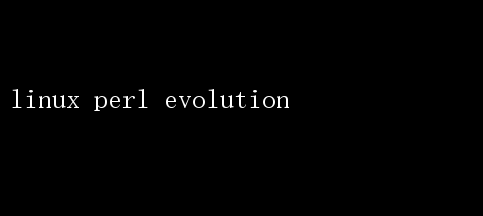
Linux Perl Evolution: A Dynamic Duo Shaping the Future of Computing
In the vast, ever-evolving landscape of computing, few combinations have left as indelible a mark as the synergy between Linux and Perl. From their humble beginnings to their current status as indispensable tools in the tech arsenal, these two entities have not only shaped the way we approach system administration and scripting but have also played pivotal roles in the broader evolution of computing paradigms. This article delves into the intertwined history, evolution, and ongoing significance of Linux and Perl, illuminating why this dynamic duo continues to be a cornerstone in the tech world.
The Genesis of Linux and Perl
Linux, born out of the necessity for a free, open-source Unix-like operating system, has come a long way since its inception in 1991 by Linus Torvalds. Initially, Linux was a hobbyist project aimed at providing an alternative to the expensive, proprietary Unix systems prevalent at the time. Torvalds vision resonated with a community of developers who contributed code, documentation, and support, turning Linux into a robust, versatile OS that could run on virtually any hardware configuration.
Perl, on the other hand, emerged slightly earlier, in 1987, as a practical extraction and reporting language created by Larry Wall. Wall designed Perl with a specific goal in mind: to make text processing and report generation easier for system administrators. Perls syntax borrowed freely from C, sed, awk, and other languages, creating a powerful, flexible scripting tool that could handle complex text manipulation tasks with ease.
Early Days: Complementary Strengths
From the outset, Linux and Perl were natural companions. Linux provided a stable, free operating system platform, while Perl offered a versatile scripting language that could automate tasks, manage files, and interface with system utilities. Administrators quickly realized the potential of combining these tools, using Perl scripts to automate system maintenance, monitor performance, and streamline administrative workflows.
One of the early milestones in this symbiotic relationship was the development of system administration tools like`cron`, which allowed for scheduled task execution,and `sed`/`awk` for text processing. Perl augmented these tools, offering more sophisticated pattern matching, string manipulation, and array handling capabilities. Scripts written in Perl could now automate complex administrative tasks, reducing manual intervention and improving operational efficiency.
The Perl Communitys Role in Linux Evolution
As Linux gained traction, so did the Perl community. The Perl Monks, an online forum, and the Perl Foundation emerged, fostering a vibrant ecosystem of developers, users, and contributors. These communities were not just about sharing code and solving problems but also about advocating for Perls adoption and integration into various platforms, including Linux.
Perls influence on Linux was felt in several key areas:
1.System Administration Tools: Tools like apt-get (Debian-based package management) and`yum` (Red Hat-based package management) incorporated Perl scripts to handle dependencies, repository management, and package installations. Perls ability to parse and manipulate text made it an ideal choice for managing configuration files and system logs.
2.CGI Scripting: In the early days of the web, Perl was the dominant language for writingCGI (Common GatewayInterface) scripts. These scripts enabled dynamic content generation on web servers, such as Apache, which often ran on Linux. Websites could now display personalized content, process user inputs, and interact with databases using Perl-based backends.
3.Network Programming: Perls rich set of libraries for network programming made it a go-to language for developing network tools and protocols. Libraries like`Net::SMTP,Net::FTP`,and `Net::HTTP` allowed developers to create client-server applications, manage email, and transfer files over various protocols, all seamlessly integrated with Linuxs robust networking stack.
Evolution: Modern Perl and Linux
As technology advanced, so did the capabilities of Linux and Perl. Linux distributions like Ubuntu, Fedora, and CentOS introduced more user-friendly interfaces, improved hardware support, and robust security features. Simultaneously, Perl evolved, incorporating new features, enhancing performance, and improving modularity.
Perl 5, released in 1995, introduced object-oriented programming capabilities, regular expression enhancements, and a more consistent API. This version laid the groundwork for Perls continued relevance in a rapidly changing technological landscape. Perl 6, later renamed Raku, represents an even more ambitious evolution, aiming to address performance bottlenecks, improve concurrency handling, and introduce more modern syntax constructs.
Linuxs evolution has been equally impressive. The Linux kernel has undergone numerous versions, each introducing enhancements in security, stability, and performance. Features like namespaces, cgroups, and KSM(Kernel Samepage Merging) have made Linux an ideal platform for contai
